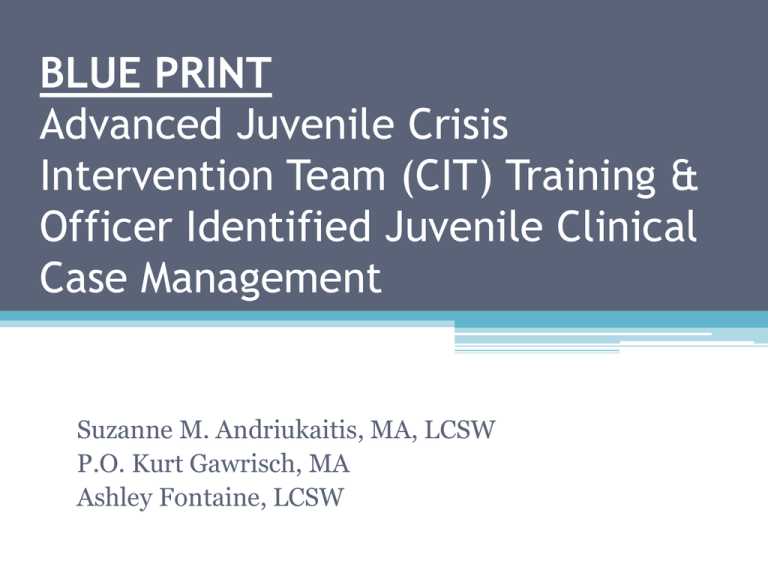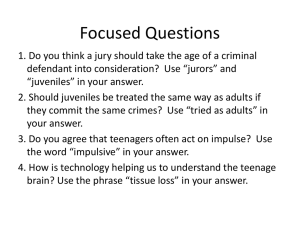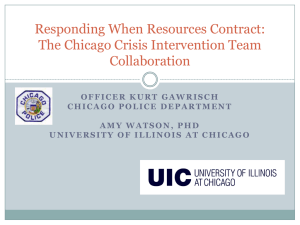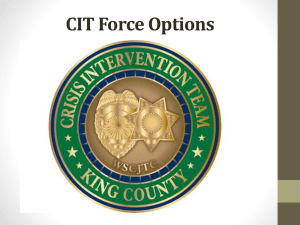BLUE PRINT Advanced Juvenile Crisis
advertisement

BLUE PRINT Advanced Juvenile Crisis Intervention Team (CIT) Training & Officer Identified Juvenile Clinical Case Management Suzanne M. Andriukaitis, MA, LCSW P.O. Kurt Gawrisch, MA Ashley Fontaine, LCSW Rationale for the development of this two component program: • After several classes of the Basic 40-hour CIT training, Chicago police officers assigned to schools and other officers working primarily with juveniles asked for additional training on handling juveniles in crisis. They also wanted additional training about legal and service issues that applied to juveniles. • If juveniles are being diverted by officers from arrest for behaviors or offenses related to mental health crises, then it follows that in order to mitigate against future involvement with law enforcement officers there is a need to intervene with these juveniles and their family members to enhance involvement in the mental health service system and access to social services. Program Goal: The overall goal of this program is to reduce the arrest or re-arrest of juveniles identified by CIT officers as having unaddressed mental health needs. Program Objectives: • The primary objective of this program is to develop and provide Advanced Juvenile 40-hour CIT training for 360 Chicago police officers who had completed the Basic CIT training. • A second objective of this project is to assist juveniles and their family members to connect firmly with mental health providers. • A third objective is to assist juveniles and their family members to identify and resolve other social service needs. Part I. Advanced Juvenile Crisis Intervention Team (CIT) Training A. Pre-Program Landscape – Necessary Building Blocks • • • • ▫ ▫ ▫ ▫ ▫ ▫ Basic 40-hour Crisis Intervention Team (CIT) training for law enforcement officers is in place and well received by officers and community partners. Ongoing collaborative working relationships among: law enforcement officers mental health providers inpatient psychiatric hospitals – drop-off hospitals Chicago Public School system juvenile justice programs advocacy organization Recognition of the Need for Juvenile CIT training by law enforcement officers. A potential source of funding for the costs of program delivery B. Idea Launch - Needs Assessment, Capacity, & Potential Funding Sources • • • • • • Officer Enthusiasm - Basic CIT trained officers asking in large numbers for additional training about juvenile mental health signs & symptoms, laws specific to juveniles, information about mental health service providers, and best practices when interfacing with distressed juveniles. Evaluate numbers of Basic CIT trained officers in your community who regularly interface with juveniles (school officers, etc.) Identifiable/Quantifiable/Data-based Need(s) in your community for intervention with juveniles who come in contact with law enforcement officers. Evaluate your capacity to develop a program – time, expertise, funding, & programmatic support up the chain of command. Research other existing similar programs. Identify more secure prospect(s) for funding. C. Program Development – Stage 1 – Building the Juvenile CIT Curriculum • • • • • • • Identify key stakeholders, secure their agreement, uncover and deal with resistance. Secure Department Head(s) agreement with the concept, uncover and deal with resistance. Hold discussion meeting(s) with stakeholders from the above named list of collaborators to obtain buy-in for building the training program. Identify essential core elements of instruction for the training. Involve collaborators in building the training program education blocks, set time tables for deliverables, and provide technical and logistical assistance. Share the deliverables with the entire group of collaborators. Secure firm commitment from potential expert presenters. D. Program Development – Stage 2 – Grant Writing / Funding the Program • • • • • • • • Identify the two or three key persons to involve in the grant writing process. Clarify the goals and objectives of the program among these key persons and share this with the broader stakeholder group. Research and consider all genuine potential funders – federal, state, local, foundations, department funds, private donors, etc. Identify a grant writer skilled at writing grants for the specific potential funding source. As the grant writing progresses stay on top of which of your collaborators need specific involvement in the day to day grant activities, secure their agreement and keep them in the loop as the grant activities are being committed to paper. Reassess and justify the number of officers, size of classes, and other quantifiable numbers. Develop the budget needed as the grant activities are being spelled out. Sustainability - Develop evaluation plans to justify continuation of the program and securing ongoing funding for the program. E. Program Development – Stage 3 Delivery of the Advanced Juvenile CIT Training • • • • • • • ▫ ▫ ▫ Comply with all paperwork required by the funding source. Set training date(s), request applications from officers (voluntary), review applications for suitability, enroll officers. Secure training location. Reconfirm presenters. Prepare handouts, pre-post evaluations, daily evaluations of presentations, coffee, snacks and other logistics. Deliver the training. Post the training – Re-evaluate and reassess content, presenters, etc. Hold focus groups or other means of feedback from officers. Mechanism of support for the officers. Part II. Officer Identified Juvenile Clinical Case Management A. Pre-Program Landscape – Necessary Building Blocks • • • • ▫ ▫ ▫ ▫ ▫ ▫ Trained Advanced Juvenile (CIT) officers. A provider or organization with expertise in providing information, referrals, education, support, and advocacy for juveniles and their families. Capacity to provide or a means of securing ongoing clinical supervision of case workers. Provider or organization with ongoing collaborative working relationships with: law enforcement officers mental health providers inpatient psychiatric hospitals – drop-off hospitals juvenile justice programs advocacy organizations schools of social work and professional psychology. B. Idea Launch – After Securing Funding for the Program • • • • • Our grant funding required the creation of positions as a condition of applying for the funding. Therefore, the grant writer wrote in 2 ½ positions for graduate level interns. Initial meeting with CIT Coordinators and representatives of area professional schools and drop-off hospitals to secure their buy-in and explore methods of securing supervision for project interns. Original plan was for project interns to be based at the hospitals to greet juveniles and their families at the time of hospital admission. Deemed unrealistic for a multitude of reasons. Held monthly meetings with professional school and hospital personnel to update and refine plans. Developed Memorandum of Understanding between the professional graduate schools and NAMI of Greater Chicago. AND…. • • • • Explored possible overlapping of activities between this project’s workers and state of Illinois Department of Mental Health paid for agency workers in the SASS (Sreening, Assessment, & Support Services) programs. Determined that while overlap of goals existed these were for the most part on paper only since the SASS workers were primarily carrying out the task of approving or rejecting a juvenile’s need for hospitalization and only rarely providing the kind of intervention services being proposed for this project. Interviewed and selected potential project interns. Completed all paperwork required by funding source in order to obtain the promised dollars. Continue ongoing reporting to funding source as required. C. Program Development – Stage 1 – Crafting the Tools for Case Management • • • • • • • • Interns sat in on the 40-hour Advanced Juvenile CIT training as early in their internship as possible. Reviewed and updated all Referral Resources in NAMI of Greater Chicago’s database that dealt specifically with children and adolescents. Trained interns to use NAMI of Greater Chicago’s Referral Database. Prepared materials describing the program and NAMI of Greater Chicago for distribution at the hospitals and to CIT officers during the trainings. Developed consent forms for juveniles and their parents to sign. Began the development of a database to track project clients – juveniles, their parents, and sometimes other siblings. Met with research evaluators from local universities to plot potential data for evaluating the project. Located a straight forward self-evaluation tool for juveniles, their parents, and project staff to complete on a periodic basis in order to track progress. We are using the Columbia Impairment Scale (CIS). D. Program Development – Stage 2 – Securing and Initiating Contact with Juveniles - Initial • • • Outreach visits to Advanced Juvenile CIT trained school officers at their school locations to acquaint them with project staff and remind them of the project objectives Project staff visited drop-off hospitals’ intake staff to explain this project and the objective of working with juveniles identified by officers as potentially having mental health issues in an attempt to secure hospital’s willingness to notify NAMI of Greater Chicago of these evaluations/admissions. Development of a monthly ‘coffee meeting’ between project staff and Advanced Juvenile CIT trained officers to address their concerns and issues. E. Program Development – Stage 3 – Delivering Services to Juveniles & Their Families • • • • • • Meet with juveniles and their family members to offer the free information and referral services of NAMI of Greater Chicago. Develop friendly helpful relationships by addressing needs identified by juveniles and their family members as they see them. E.g.., a need for warm, winter clothing, IDs, IEPs. Project staff interfaced with providers and programs to secure potential enrollment. Project staff researched programs to meet expressed needs. E.g., an after-school boxing class for a 12 year old. Database was refined to allow for tracking of additional information. Data collection and entry on an ongoing basis. F. Evaluating the Project – Stage 4 • • • • • Developing skills in using SPSS to analyze and graph data. Met regularly with research evaluators from the universities to refine data gathering based on the experiences of the project in the first several months. Hold ongoing periodic (quarterly) meetings with CIT central training staff and with personnel from the professional schools supplying the project interns. Focus groups or ongoing electronic contact with trained CIT officers. Follow-up meetings with officers and relevant school staff. G. By Products • Ongoing consultation with hospitals regarding intake procedures ▫ paperwork to track officer drop-offs ▫ physical locations for drop-offs. • Training for Dispatch/911 Call Takers to identify mental health needs and route to CIT officers. • Z code to identify CIT trained officers. • Training of School personnel – Security, principals, etc. H. Lessons Learned • Baseline Data ▫ # of kids arrested ▫ Community demographics • Extensive Resource Directory • Funding for meeting physical needs &/or emergencies • Identifying community-wide gaps Thanks for your attention • For additional information: (312) 563-0445 ▫ Suzanne Andriukaitis – namigc@aol.com ▫ Ashley Fontaine – ashley@namigc.org ▫ Kurt Gawrisch – kurt.gawrisch@chicagopolice.org









